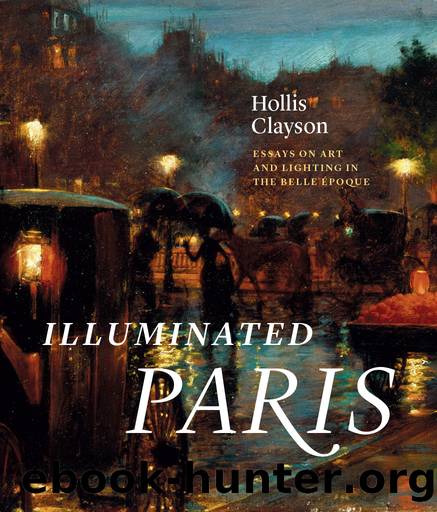Illuminated Paris by Hollis Clayson

Author:Hollis Clayson [Clayson, Hollis]
Language: eng
Format: epub
Publisher: University of Chicago Press
5.3 Henri Evenepoel, La Nuit à Paris, c. 1895. Oil on canvas. 65 à 81 cm. (25.6 à 31.9 in.). Clemens-Sels-Museum, Neuss. Image © Clemens Sels Museum Neuss. Photo: Jörg Schanze, Düsseldorf.
5.4 Charles Courtney Curran. Illumination at the Exposition, 1889. Oil on board. 11.43 à 31.4 cm. (4½ à 123/8 in.). Signed and dated at lower left: Chas C Curran 89. Courtesy of Adelson Galleries, New York.
Childe Hassam in Paris
Hassamâs work is rich terrain for this line of analysis, because as William H. Gerdts observed: âHassam was the initial American artist to gain renown as a painter of urban views.â44 Hassam, considered a key American Impressionist, was a Bostonian (from Dorchester) by birth. Largely self-taught and a high school dropout, he worked as an illustrator from 1882 and began exhibiting his watercolors at a gallery in 1883. A friend persuaded him of the need to get to Europe to look at art there. He took a five-month trip to six countries in the summer of 1883. A sojourn in Paris was a necessary and logical next step. Hassam and his wife, Maude Hassam (née Kathleen Maude [or Maud] Doane), remained in Paris and the nearby countryside (at Villiers-le-Bel) for most of their three years abroad, from 1886 to 1889.45 Like Curran, he studied at the Académie Julian and exhibited in the Paris Salon; his work was also seen in the Exposition Universelle of 1889.46 He turned thirty on shipboard on the way home.
Upon their return to the United States in 1889, the Hassams settled in New York City. Childe Hassam made common cause thereafter with other Impressionists (Theodore Robinson, John Henry Twachtman, and J. Alden Weir) and the poet Celia Thaxter, and painted frequently in leading East Coast artistsâ colonies, including Cos Cob, Appledore Island, Gloucester, and Old Lyme. While frequently painting the American countryside, he continued to hone his reputation as a painter of cities.
For the most part, while he was in Paris, Hassam was offhand or cheerful about the Franco-American relationship. He did make caustic remarks about contemporary art, both academic and vanguard, but judging from his letters he estimated that personally he got on all right. âWe lived among French people, spoke French,â he recalled. âIt was a French house and we wanted to speak French.â47 Aggravation with the French did surface in some of his letters. In an April 8, 1889, letter to William Howe Downes, a critic for the Boston Evening Transcript, he wrote acerbically: âIf you could live over here a couple of years to see how things are run here in art matters it would make you sick. Americans ought to know this. It ought to be shown up. The âFrench disinterestednessâ does not exist for any stranger.â48 And Hassam certainly had a low regard for the official and unofficial wings of the much-admired French art education system. In another letter to Downes (May 28, 1889), he observed: âI believe too much of this foreign study for Americans is going to do what the Prix de Rome system has done and is doing for France.
Download
This site does not store any files on its server. We only index and link to content provided by other sites. Please contact the content providers to delete copyright contents if any and email us, we'll remove relevant links or contents immediately.
Sketching User Experiences by Saul Greenberg(426)
Interior Design for Autism from Childhood to Adolescence by A. J. Paron-Wildes(403)
Plain Simple Useful by Terence Conran(379)
The Fundamentals of Fashion Design by Richard Sorger and Jenny Udale(368)
Making Costume Jewelry: An Easy & Complete Step by Step Guide by Janet Evans(364)
A Hut of One's Own: How to Make the Most of Your Allotment Shed by Emily Chappell(352)
3D Printing for Artists, Designers and Makers by Hoskins Stephen(343)
Racinet's Historic Ornament in Full Color by Auguste Racinet(335)
Illuminated Paris by Hollis Clayson(332)
Do You Feel Like I Do? by Peter Frampton & Alan Light(314)
The Basics of User Experience Design: A UX Design Book by the Interaction Design Foundation by Mads Soegaard(313)
Data Driven Design: How Today's Product Designer Approaches User Experience to Create Radically Innovative Digital Products by Phillip A. Harris(312)
Illustrated Guide to Door Hardware: Design, Specification, Selection by Tobias Scott;(269)
Easy Ikebana by Shinichi Nagatsuka(263)
Historic English Costumes and How to Make Them by Talbot Hughes(263)
Textiles and Gender in Antiquity by Mary Harlow;Cecile Michel;Louise Quillien;(243)
Contemporary Japanese Restaurant Design by Motoko Jitsukawa & Cornucopia K. K(234)
Launching the Imagination 3D by Stewart Mary & Stewart Mary(234)
